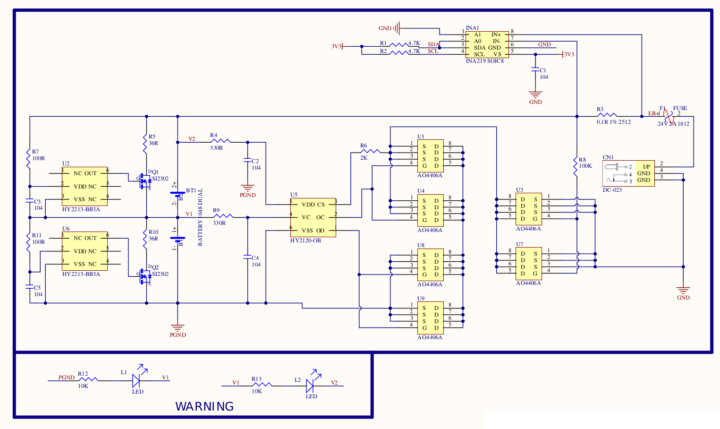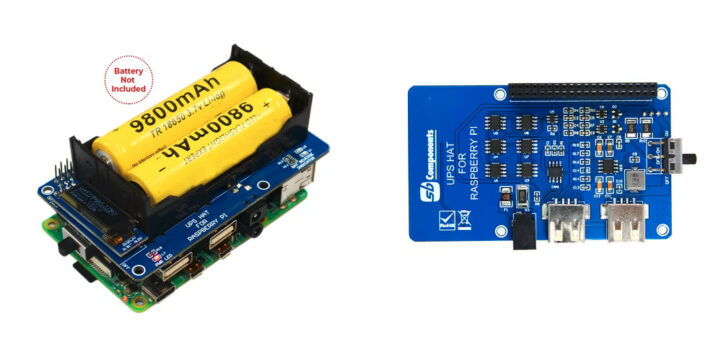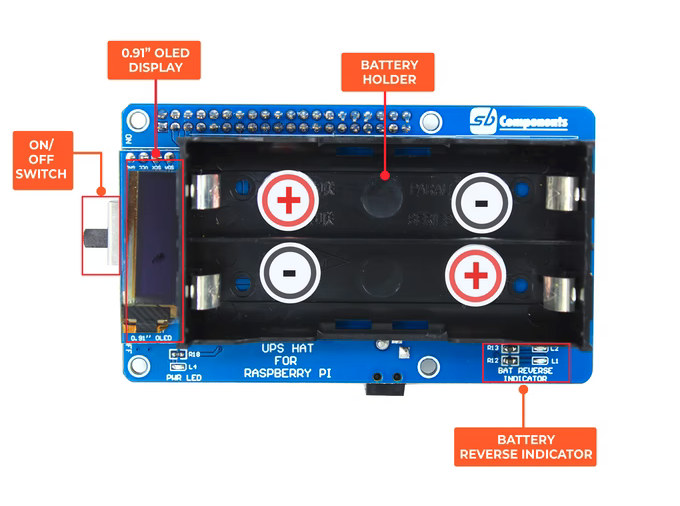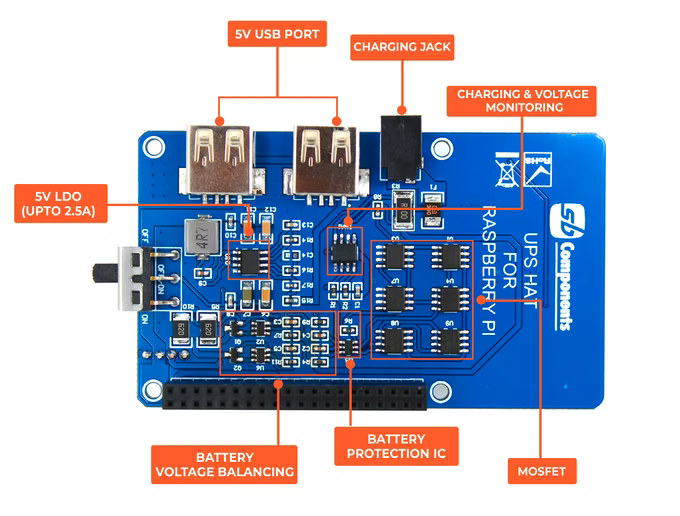Raspberry Pi UPS solutions have been available for years with products like PiJuice Zero, PiVoyager, or LiFePO4wered/Pi+. But the team at SB Components has designed another UPS HAT for Raspberry Pi with a holder for two 18650 batteries.
The HAT is designed for 5V operation up to 2.5A, connects with the Raspberry Pi SBC through the I2C bus from the 40-pin GPIO header, and is equipped with a 0.91-inch OLED for information display.
UPS HAT for Raspberry Pi specifications:
- Power Input – 8.4V/2A via DC jack
- Power Output – 5V up to 2.5A through LDO chip (GPIO header and 2x USB ports)
- Display – 0.91-inch OLED
- Host interface – I2C
- Misc – On/Off switch
- Battery support
- 18650 Lithium battery (not included) via holder for two batteries
- Battery reverse indicator
- Charging and voltage monitoring via TI INA219 I2C chip
- Battery voltage balancing with Hycon HY2213
- Battery protection IC (Hycon HY2120)
- Dimensions – 94.5 x 56 mm; 3mm mounting holes
A couple of weeks ago, I wrote about a DIY FM radio kit that connected a 18650 battery directly to the power supply, but this HAT is much better with charging and protection circuits (See schematics below). Users are however still advised to follow some precautions when using the board:
- When discharging or charging the battery, do not connect the polarities in the opposite direction
- Lithium-ion and Lithium-Polymer batteries are notoriously unstable, and may cause fire, human harm, or property damage if not used correctly
- Do not mix old and new batteries, do not use batteries from various brands.
- Change the battery after 2 years
- Check the battery specifications match the expansion’s board
- Keep batteries away from flammable and explosives, and keep them away from children
These recommendations are valid for any Lithium-based batteries though.

SB Components will usually share the code for their products on Github, but the source code for the UPS HAT for Raspberry Pi is not available yet.
You’ll find the project on Kickstarter where it has raised around $10,000 so far. Rewards start at $41 (30 GBP) for the UPS HAT, an 8.4V battery charger, two 20-pin female headers, and six standoffs. The company also offers bundles with multiple UPS HATs, or a mix-and-match with some of their other Raspberry Pi add-ons. Shipping adds 5 GBP to the UK, around 8.3 Euros to the European Union, and about $20 to the rest of the world. Deliveries are scheduled to start on February 2022.

Jean-Luc started CNX Software in 2010 as a part-time endeavor, before quitting his job as a software engineering manager, and starting to write daily news, and reviews full time later in 2011.
Support CNX Software! Donate via cryptocurrencies, become a Patron on Patreon, or purchase goods on Amazon or Aliexpress








they really put those ultra(house)fire battery to the battery holder
lol
Power Output – 5V up to 2.5A through LDO chip (GPIO header and 2x USB ports)
Using LDO for such high current loads is so inefficient.
Also in one of the images I could spot a power inductor, I think there is a buck converter to deliver the 5V output and not an LDO.
Note: A UK company, so sending from the UK/non-EU to the EU will cost the buyer VAT, plus service cost for collecting the VAT (10-20 Euro?).
Unless SB Components pays the EU-VAT upfront (like Aliexpress does). I can’t remember the name for that right now.
I am looking for a power supply for handheld console. Can someone suggest. What will be needed for reliable minimum 2.4A output. Something like the post but USB .
1. Where is the complete schematic? Where is the firmware? There’s a big “Open Source with Logo” slapped on the Kickstarter page but I can’t find links to anything substantive.
2. Those Taiwanese HYCON HY2213 1S BMS chips look like unobtainium. Good luck fulfilling that Kickstarter!
https://www.lcsc.com/product-detail/PMIC-Battery-Management_HY2213-BB3A_C113632.html
3. I agree with @boggyb, that “5V LDO (UP TO 2.5A)” call-out on the board diagram must be an error. To me the SOIC-8 chip and the SMT 4R7 inductor next to the “LDO” call-out screams a buck-converter to me used to bring down the 2S 8.4V to 5V. But we can never be sure without a complete schematic.
4. The AO4406A N-FETs are crazy expensive due to the chip shortage – when you can find them.
https://lcsc.com/product-detail/MOSFETs_Alpha-Omega-Semicon-AO4406A_C400893.html
Pick a better part, P-FETs this time around would be more efficient. HYCON makes complementary chips for P or N-FETs.
5. $20 shipping to anywhere except the UK/EU? What’s up with that? Crazy prices to ship from the UK? Contract manufacture and drop-ship from China for peanuts. Or better-yet just truly “Open Source” the thing; in a couple of days cheap Chinese clones will pop-up on Aliexpress and Ebay.